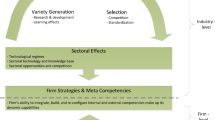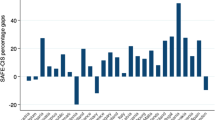Abstract
This paper investigates empirically the impact of diversity on the innovation performance of a firm. We created a measure for diversity that mirrors differences in the resource base of firms within an industry and tested its impact in addition to more traditional factors such as technology-push, demand-pull, and firm-size, based on panel data stemming from three representative cross sectional surveys carried out in the years 1996, 1999, and 2002, respectively. In fact, diversity has a significant positive impact on the innovation intensity of firms and thus supports more theoretical findings in this area. We also find empirical evidence for the technology push and the demand pull hypotheses, as well as the importance of competition for innovation.

Similar content being viewed by others
Notes
The SIS is very similar to the CIS.
The term “diversity” or “diverse” is motivated by the definition given in Section 3. Heterogeneous is used synonymously with diversity.
Utterback (1996) describes the history of companies that were unable to change their innovation behavior, since they stuck to their “sunk” investments and technologies, although newer (better) technologies were already on the market.
Solow et al. (1993) and Weitzman (1992; Weitzman (1993) measured diversity based on genetic distances. They defined the value of a species for the diversity of a subsample S, according to the “genetic” distance to other species element of S. The genetic distances are measured, e.g. based on a taxonomic tree. Such a tree indicates the ancestors of a specific species and the time passed from its separation from the species. Thus the longer ago a species separated from another one, the greater is its “genetic” distance. This approach can be seen as a conceptual starting point for the Nehring and Puppe (2002) measure.
X i = value in line i of firm vector \(\boldsymbol{X}\); Y i = value in line i of firm vector \(\boldsymbol{Y}\).
If we would change to a three digit level, we would have 191 different markets. In 118 markets we would have fewer than 20 observations. In 88 markets we would have fewer than ten firms and still, in 40 markets, there would be fewer than four observations.
The importance of size for innovation performance on an industry level was also shown by Majumdar (1995) for the telecommunication sector. Tsai (2001) showed that even the size of business units impacts innovation behavior. The share of exports and R&D expenditures also impact the way firms organize their R&D. This was found in additional calculations based on the empirical models applied in Woerter (2007). The empirical data do not enable us to dig deeper into the driving forces for organizational routines, as investigated in Feldman (2000), or Becker et al. (2005).
Standardization was conducted using SAS software according to the following formula: \(x_i =\frac{S\times \left( {{x}'_i -\bar {X}} \right)}{S_x }+M\); while x i is the new standardized value, S is the chosen standard deviation value, M is the mean value, S x is the variables standard deviation, x′ i is the observation’s value, and \(\;\overline{{\kern-2pt}X}\) is the variables mean.
This figure represents the response rate for the manufacturing sector. The response rate for the service sector and the construction sector amounts to 31.6%. The respective figures for 1999 and 2002 cover all three sectors.
In order to carry out this calculation, we used the STATA software.
The Heckman estimation, the test for heteroscedasticity and autocorrelation are not presented in the paper.
References
Arvanitis S, Hollenstein H (1996) Industrial innovation in Switzerland: a model-based analysis with survey data. In: Kleinknecht A (ed) Determinants of innovation, the message from new indicators. Macmillan, London, pp 13–62
Becker MC, Lazaric N, Nelson RR, Winter SG (2005) Applying organizational routines in understanding organizational change. Ind Corp Change 14(5):775–791. doi:10.1093/icc/dth071
Brouwer E, Kleinknecht A (1996) Determinants of innovation: a micro econometric analysis of three alternative innovative output indicators. In: Kleinknecht A (ed) Determinants of innovation, the message from new indicators. Macmillan, London, pp 99–124
Chiaromonte F, Dosi G (1993) The micro foundations of competitiveness and their macroeconomic implications. In: Foray D, Freeman Ch (eds) Technology and the wealth of nations. Pinter, London, pp 107–134
Cohen WM (1995) Empirical studies of innovative activity and performance. In: Stoneman P (ed) Handbook of the economics of innovation and technological change. Blackwell, Oxford
Cohen WM, Levin RC (1989) Empirical studies of innovation of market structure. In: Schmalensee R, Willig R (eds) Handbook of industrial organization. North-Holland, Amsterdam
Crépon B, Duguet E, Mairesse J (1998) Research and development, innovation and productivity: an econometric analysis at the firm level. Econ Innov New Technol 7(2):115–158
Davis R, Thomas LG (1993) Direct estimation of synergy: a new approach to the diversity–performance debate. Manag Sci 39(11):1334–1346
Dosi G (1988) Sources, procedures, and microeconomic effects of innovation. J Econ Lit 26:1120–1171 (September)
Dosi G (2005) Statistical regularities in the evolution of industries. A Guide through some evidence and challenges for the theory. LEM working-paper series 2005/17, Pisa
Feldman MS (2000) Organizational routines as a source of continuous change. Organ Science 11(6):611–629 (November–December)
Feldman MP, Audretsch DB (1999) Innovation in cities: science-based diversity, specialisation and localized competition. Eur Econ Rev 43:409–429
Glaeser E, Kallal H, Scheinkam J, Shleifer A (1992) Growth in cities. J Polit Econ 100:1126–1152
Greunz L (2004) Industrial structure and innovation—evidence from European regions. J Evol Econ 14:563–592. doi:10.1007/s00191-004-0234-8
Griliches Z, Mairesse J (1997) Production function: the search for identification. In: Strøm S (ed) econometrics and econmic theory in the Twentieth Century: the Ragner Frisch Centennial Symposium. Cambridge University Press, Cambridge, MA
Heckman JJ (1976) The common structure of statistical models of truncation, sample selection, and limited dependent variables and a simple estimator for such models. Ann Econ Soc Meas 5:475–492
Henderson V, Kuncoro A, Turner M (1995) Industrial development in cities. J Polit Econ 103(5):1067–1090
Holland JH, Holyoak KJ, Nisbett RR, Thagard PE (1986) Induction—processes of inference, learning, and discovery. MIT, Boston, MA
Jacobs J (1969) The economy of cities. Random House, New York
Jacquemin AP, Berry CH (1979) Entropy measure of diversification and corporate growth. J Ind Econ 27(4):359–369
Janz N, Lööf H, Peters B (2003) Firm level innovation and productivity—is there a common story across countries? Probl Perspect Manag 2:1–22
Lazaric N, Denis B (2005) Routinization and memorization of tasks in a workshop: the case of the introduction of ISO norms. Ind Corp Change 14(5):873–896
Llerena P, Oltra V (2002) Diversity of innovative strategy as a source of technological performance. Struct Change Econ Growth 13:179–201
Mairesse J, Mohnen P (2001) To be or not to be innovative: an exercise in measurement. MERIT-Infonomics Research Memorandum series Nr. 2001-039, MERIT, Maastricht
Majumdar SK (1995) The determinants of investment in new technology: an examination of alternative hypotheses. Technol Forecast Soc Change 50:235–247
Mansfield E (1968) The economics of technical change. Norton, New York
March JG (1994) Three lectures on efficiency and adaptiveness in organization. First Goran and Louise Ehrnrooth Lectures, Helsinki
Metcalfe JS, Miles I (1994) Standards, selection and variety: an evolutionary approach. Inform Econ Policy 6:243–268
Mohnen P, Dagenais M (2001) Towards an innovation intensity index. The case of CIS 1 in Denmark and Ireland. In: Kleinknecht A, Mohnen P (eds) Innovation and Firm Performance. Econometric Explorations of Survey Data. Palgrave, London
Nehring K, Puppe C (2002) A theory of diversity. Econometrica 70(3):1155–1198
Nelson RR (1959) The simple economics of basic scientific research. J Polit Econ 67:297–306
Nelson RR (1995) Recent evolutionary theorizing about economic change. J Econ Lit 33:48–90 (March)
Nelson RR (2006) Commentary on Sidney Winter’s “Toward a neo-Schumpeterian theory of the firm”. Ind Corp Change 15(1):145–149
Nelson RR, Winter SG (1982) An evolutionary theory of economic change. Belknap of Harvard University Press, Cambridge, MA
Nguyen P, Saviotti PP, Trommetter M, Bourgeois B (2005) Variety and the evolution of refinery processing. Ind Corp Change 14(3):469–500
Pentland BT, Feldman MS (2005) Organizational routines as a unit of analysis. Ind Corp Change 14(5):793–815
Phillips A (1966) Patents, competition, and technical progress. Am Econ Rev 56:301–310
Raymond W, Mohnen P, Palm F, Van der Loeff SS (2004) An empirically-based taxonomy of Dutch manufacturing: innovation policy implications. MERIT-Infonomics Research Memorandum series 2004-011, MERIT, Maastricht
Robins J, Wiersema MF (1995) A resource-based approach to the multibusiness firm: empirical analysis of portfolio interrelationships and corporate financial performance. Strateg Manage J 16(4):277–299
Rosenberg N (1976) Perspectives on technology. Cambridge University Press, Cambridge, MA
Saviotti PP (1996) Technological evolution, variety and the economy. Edward Elgar, Cheltenham
Saviotti PP, Mani GS (1995) Competition, variety and technological evolution: a replicator dynamics model. J Evol Econ 5:369–392
Schmookler J (1966) Invention and growth, Schumpeterian perspectives. MIT, Cambridge, Mass
Schumpeter AJ (1912) Theorie der wirtschaftlichen entwicklung. Duncker und Humblot, Leipzig
Schumpeter AJ (1975) Capitalism, socialism and democracy. Harper Perennial, New York
Silverberg G, Dosi G, Orsenigo L (1988) Innovation, diversity and diffusion: a self-organisation model. Econ J 98:1032–1054 (December)
Simon HA (1956) Rational choice and the structure of the environment. In: Egidi M, Marris R (eds) Economics, bounded rationality and the cognitive revolution, Herbert Simon. Edward Elgar, Aldershot, Brookfield (rev. 1992)
Simon HA (1981) Entscheidungsverhalten in Organisationen. Verlag Moderne Industrie, Munich
Solow A, Polasky St, Broadus J (1993) On the measurement of biological diversity. J Environ Econ Manage 24:60–68
Stirling A (1998) On the economics and analysis of diversity. SPRU electronic working paper series, paper no. 28, October
Stirling A (2004) Diverse design: fostering technological diversity in innovation for sustainability. Paper submitted to Colloquium DEA, Durham Business School and Cranfield School of Management on: the role of diversity in social systems and its relation to innovation, Bologna, 12–13 July
Stirling A (2007) A general framework for analysing diversity in science, technology and society. J R Soc Interface 4:707–719
Tsai W (2001) Knowledge transfer in intraorganizational networks: effects of network position and absorptive capacity on business unit innovation and performance. Acad Manage J 44(5):996–1004
Utterback JM (1996) Mastering the dynamics of innovation. Harvard Business School, Boston, MA
Weitzman ML (1992) On diversity. Q J Econ 107(2):363–405 (May)
Weitzman ML (1993) What to preserve? An application of diversity theory to crane conservation. Q J Econ 108(1):157–183 (February)
Wernerfelt B (1984) A resource-based view of the firm. Strateg Manage J 5:171–180
Winter SG (2006) Toward a neo-Schumpeterian theory of the firm. Ind Corp Change 15(1):125–141
Woerter M (2007) Driving forces for research and development strategies. KOF working paper no. 184, Zurich. www.kof.ethz.ch
Wooldridge JM (2002) Econometric analysis of cross section and panel data. MIT, Cambridge, MA
Acknowledgements
I would like to thank N. Sydow for programming SAS macros in order to apply the measure of diversity. Many thanks also to N. Lazaric and Th. Brenner (discussants at the Druid Conference 2007) and S. Arvanitis, A. Mueller, and the participants of the KOF research seminar for their valuable comments on the paper.
Author information
Authors and Affiliations
Corresponding author
Appendix
Rights and permissions
About this article
Cite this article
Woerter, M. Industry diversity and its impact on the innovation performance of firms. J Evol Econ 19, 675–700 (2009). https://doi.org/10.1007/s00191-008-0118-4
Published:
Issue Date:
DOI: https://doi.org/10.1007/s00191-008-0118-4




